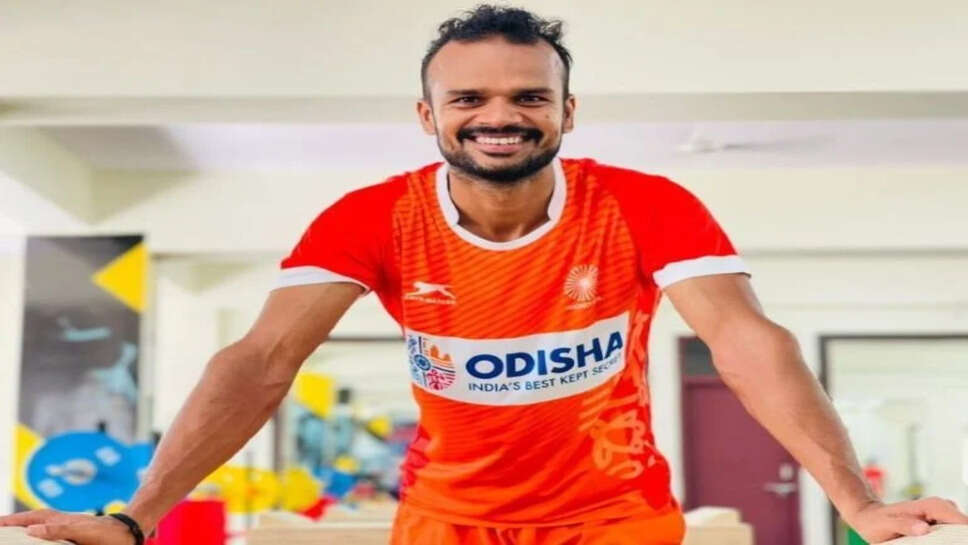Wristy Wizardry and Kamartod Dribbles: How Lalit Upadhyay Brought Style to Indian Hockey

Lalit Upadhyay, born on September 2, 1993, in Varanasi, Uttar Pradesh, emerged onto India’s hockey scene with an unconventional blend of flair and finesse. Known for his exquisite wristwork and signature kamartod dribbles that flipped the script on standard forward play, Upadhyay brought a cinematic, almost poetic quality to field hockey. His style didn’t just rack up goals—it captivated audiences, challenged norms, and left an indelible mark on Indian hockey’s aesthetic and tactical evolution.
1. Early Life: From Varanasi bylanes to National Spotlight
Growing up in a city steeped in tradition, Upadhyay’s love for hockey took root in dusty bylanes and playground tournaments. Unlike his peers, he wasn’t drawn to raw pace or brute force. Instead, the young Lalit was fascinated by feints, wrist flicks, and toe-play – artistic moves that required imagination, rhythm, and split-second creativity. His early coaches recognized the spark in him: a player who could improvise like a musician composing in real-time.
At the Uttar Pradesh Sports Hostel, where he trained during his teens, Upadhyay honed his artistry. Under mentors who encouraged freedom of expression, he sharpened his kamartod flick—a pivot with explosive power—and his knack for toe-dribbles that left defenders bewildered. By 2013, he was selected for the national junior team, turning heads at the FIH Under-21 World Cup before stepping into senior squad contention.
2. Breakthrough with Flair in Senior Hockey
Lalit made his senior India debut in 2014, debuting in the Champions Challenge tournament with signature style. He didn’t just satisfy the statistics-chasers; he awoke the fans. A deft drag flick here, a reverse-tip there—it was artistry in motion.
His moment of national recognition came at the 2016 Rio Olympics qualifiers. In a hype-filled clash, Upadhyay back-heeled the ball past defenders, spun in a graceful kamartod, and flicked it into the net mid-air—a goal as breathtaking as any painting. That single stroke crystallized his identity: a modern artist in cleats, unafraid to shun the mundane for the spectacular.
3. The Kamartod Dribble: Poetry in Movement
Upadhyay’s kamartod (literally “breaking one’s waist”) dribble involves a rapid pivot from left to right, waist twisting explosively as the stick flips the ball. Opponents trying to shadow him are caught off-balance; suddenly the ball is elsewhere. It’s an athletic move grounded in rhythm, balance, and spatial intelligence.
Coaches say mastering kamartod requires muscle memory refined over thousands of balcony tiles, street edges, and uneven playgrounds. For defenders, it’s a nightmare—predictability is gone. Instead, Upadhyay writes fresh lines every twist. Each flick is unpredictable artistry rooted in street-hockey improvisation.
4. Wristwork Wizardry
Upadhyay’s dexterous wrists and light grip allow lightning-quick stick turns and rapid roll-backs. On the penalty run or in tight quarters, he could shift angles in microseconds—passing, feinting, or shooting without telegraphing his intent. Unlike the baseline-style quick passing that dominates modern forward play, his quick flick responses directed split-second tempo changes.
This wristwork emerged from mimicking skateboarders in Varanasi alleys, who performed flicks and spins using ankles and levers. Upadhyay translated those motions into stick control, giving Indian hockey a more kinetic vocabulary—short, abrupt transfers of balance and direction.
5. Tactical Edge for India
Beyond the spectacle, Upadhyay’s skills gave India an announced edge in several tactical areas:
-
Quick Penalty Conversions: His wrist flicks allowed strain-free, low-trajectory shots ideal for deceptive penalty strikes.
-
Midfield Fluidity: As a midfielder-forward hybrid, he created seams between defense and attack, facilitating swift transitions.
-
Crowd-Drawing Flair: His stunning goals and flicks brought fresh audiences to hockey—TV viewers loved his replays, and fans packed stadiums to see what moves he’d invent next.
Analysts credited him with modernizing Indian forward play—now creatively oriented, not just production-focused.
6. Memorable Moments and Tournament Highlights
-
2016 Rio Qualifiers: Upadhyay’s back-heel kamartod goal gave India a 2–1 upset win over Canada.
-
2018 Sultan Azlan Shah Cup: A assist-line flick through an entire Pakistani defense line showcased his timing, pace, and vision under pressure.
-
2018–19 FIH Pro League: Two wrist-flick conversions marked a slow-match tail-wind win over the Netherlands—his creativity kept India pushing against Dutch defenses.
-
2020 Tokyo Preps: His wrist-flick passes and dribbles helped India qualify for Olympics finals, even if they narrowly missed a medal.
Each moment reflected Upadhyay’s consistency: how flair and performance, rhythm and rhythm-break, coexisted in high-stakes hockey.
7. Balancing Artistry and Grit
Critics used to say his style was “flash without physicality.” Lalit acknowledged the note, and matched skill with stamina. He trained in tactical conditioning—speed-endurance drills, strength routines, and contact readiness. His goal was to never appear beautiful to watch without also winning duels, intercepting centerline feeds, and covering ground like a true box-to-box athlete.
Knee injuries sidelined him in late 2019, and pundits questioned if his game lacked the grit for Olympic pressure. Returning in 2021, he introduced sheer aggression to his toolkit—hitting 150kg squats, earning accolades for tackling magic and midline blockades. His recovery proved that artistry needn’t be soft—it could stand tall.
8. Cultural Impact and Legacy
Upadhyay’s influence transcends mechanics. He changed how Indian children approach hockey training: street players now practice float flicks with kitchen spoons or bottle caps. His style sparked summer ball-shooting festivals in Varanasi, Lucknow, Delhi, Kolkata, inspiring creative youth to pick up sticks.
Coaches across India talk of the “Lalit ethos”—adapt fast, move fluidly, make unpredictability your weapon. In team camps, Upadhyay often shared improvisation drills: musical seats, spin-and-flick circuits, paired feint-return challenges. His presence injected joy into a sport often weighed down by structure.
9. Challenges & Critics
Despite his artful approach, Upadhyay faced questioning from traditionalists. They asked: did flair fit India’s rigid defensive training? Could kamartod be applied against bruising European backs? Would his perceptive moves scale in multi-phased champion tournaments?
Upadhyay answered steadily—heads down, flicks up. He let performance speak, stepping up when matches hung:
-
2022 Commonwealth Games: In a semifinal encounter with England, his wrist-flick convert and assist revived India’s comeback. The press labeled him “the equalizer.”
His balancing act between form and function resolved skeptics—creativity became measurable, not ornamental.
10. What the Future Holds
At 31, Lalit Upadhyay remains in his athletic prime. With Paris 2024 on the horizon, he continues to experiment—reverse toe-drills, micro-turn flicks, drag-roll passes in the D-circle. If the next cycle rewards artistry and athleticism, his name may shine among India’s all-time hockey greats.
Coaching trends now include “Upadhyay skill segments,” giving school teams micro-drill routines. And as field hockey globalizes, unique Indian rubrics like kamartod demystify the style outside South Asia. His international tweets often call coaches in Europe/USA for joint training, exporting India’s flair too.
A Living Canvas in Motion
Lalit Upadhyay is the kind of player whose highlights feel like paintings—each movement composed as carefully as lines in a poem. Whether it’s a dragging kamartod, a snap wrist flick, or a musically timed toe evade, he reminds us: hockey isn’t just metrics and stamina—it’s theater, improvisation, and emotions woven into seconds.
As Indian hockey reloads with speed, structure, and intensity, Upadhyay’s artistry persists—striking a chord between memory and possibility. He proved that creativity can fuel victories, fan love, and technique-change.
